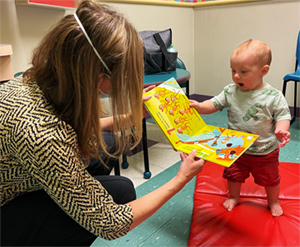University of Maryland Children’s Hospital Applauds the CDC’s Updated Child Development Milestones
Contact:
Stephanie Janard:

Expert says changes will help more children catch up to their peers sooner
BALTIMORE - For the first time in more than 20 years, the child development milestones so many parents are familiar with have been updated by the Centers for Disease Control and Prevention (CDC) in partnership with the American Academy of Pediatrics. The University of Maryland Children's Hospital supports these updated checklists and believes they will help identify developmental delays sooner. Research shows that intervening early with evidence-based practices can change a child's developmental trajectory and improve outcomes for children and families across all domains.
The previous milestones used a 50 percentile metric, which evaluated a child's developmental progress based on what half of children had (or had not) achieved by the same age. This "straight down the middle" metric left considerable ambiguity for pediatricians and parents, which likely delayed early intervention for many children who would have benefited from it. The updated guidelines adopt a 75 percentile metric, helping parents and pediatricians act sooner on early intervention for a child who is not developing at the same pace as a clear majority of other children that age.
In an example, "Begins to pass things from one hand to another" was previously listed as a 6-month milestone. This milestone now appears as "Moves things from one hand to the other hand" at 9 months of age.
According to the CDC, 1 out of every 6 children experience a developmental delay or disability, Fewer than 25 percent of these children receive services before 3 years of age.
"The new checklists provide more clarity on when to act on a potential developmental delay. You are assessing a child's development in different areas based on what 75 percent of children typically achieve by that age. That leaves much less room for interpretation than the previous 50 percent metric," said Brenda Hussey-Gardner, PhD, Co-Director of the High Risk Follow-Up Program of the Neonatal Intensive Care Unit (NICU) at the University of Maryland Children's Hospital. She is also a Professor of Pediatrics at the University of Maryland School of Medicine.
Dr. Hussey-Gardner emphasized that the new checklists supplement—not replace—the more formalized screening recommended by the AAP. Pediatricians conduct these standardized developmental screenings at the 9-month, 18-month and 30-month well-child visits, and screen for autism at the 18-month and 24-month well-child visits.
Early child development intervention in Maryland
In addition to her work at the University of Maryland Children's Hospital, Hussey-Gardner serves as the Chair of the State Interagency Coordinating Council, which advises the Maryland Infants and Toddlers Program. She pointed to the program as an example of a successful early intervention system.
"The Maryland Infants and Toddlers Program is free to every family of an eligible child. Outcomes indicate that in 2020-2021, 97 percent of families who received early intervention services report that these services assisted them to help their child develop and learn. Longitudinal research conducted in 2017 demonstrates the earlier the better, indicating that more than 68 percent of children who received early intervention services were enrolled in general education by third grade," Dr. Hussey-Gardner said.
In Maryland, children are eligible for the program if they meet one of three criteria: (1) have a high probability medical diagnosis, such as a birth weight less than 1,200 grams or Down syndrome; (2) a 25 percent delay in development, such as reaching the age of two and not talking yet; or (3) display atypical development like walking only on tiptoes at the age of 15 months.
Early intervention services to address these and other scenarios are provided in all 24 local jurisdictions in Maryland at no cost to families for children at birth to 3 years of age—in contrast to many other states that assess fees for similar services.
Early intervention through the UMCH Neonatal Intensive Care Unit
Anyone can refer a child to the Maryland Infants and Toddlers Program; including pediatricians, child-care providers, and parents.
At the University of Maryland Children's Hospital, for example, Dr. Hussey-Gardner's team monitors all infants in the hospital's neonatal intensive care unit. Drawing on different physical evaluations and medical notes from the infant's team of specialists—which can include a neonatologist, neurologist, geneticist and other clinical experts--the team identifies infants at high risk for developmental delays, consults with their families and makes referrals to the child's local Infants and Toddlers Program at the time of discharge.
Many may also be eligible for the children's hospital's NICU Follow-Up Program, which offers neurodevelopmental evaluations from birth to age 3 years and provides recommendations to help parents foster their children's development. This can include a referral to or collaboration with the child's local early intervention system.
"Early intervention works—and the updated milestones help assure that more children are referred to early intervention quicker so that they catch up to their peers sooner," Dr. Hussey-Gardner said.
For more information on the Maryland Infants and Toddlers Program, or to refer a child, visit https://referral.mditp.org/.
To learn more about the NICU Follow-Up Program at the University of Maryland Children's Hospital, visit https://www.umms.org/childrens/health-services/neonatology/nicu-follow-up-program.
About the University of Maryland Children's Hospital
The University of Maryland Children's Hospital at the University of Maryland Medical Center is recognized throughout Maryland and the mid-Atlantic region as a resource for children with critical and chronic illnesses. UMCH physicians and staff excel in combining state-of-the-art medicine with family-centered care. More than 100 physicians specialize in understanding how to treat conditions and diseases in children, including congenital heart conditions, asthma, epilepsy and gastrointestinal disorders. The Drs. Rouben and Violet Jiji Neonatal Intensive Care Unit (NICU) provides the highest level of care to the tiniest newborns. To learn more about the University of Maryland Children's Hospital, please visit http://umm.edu/childrens.
